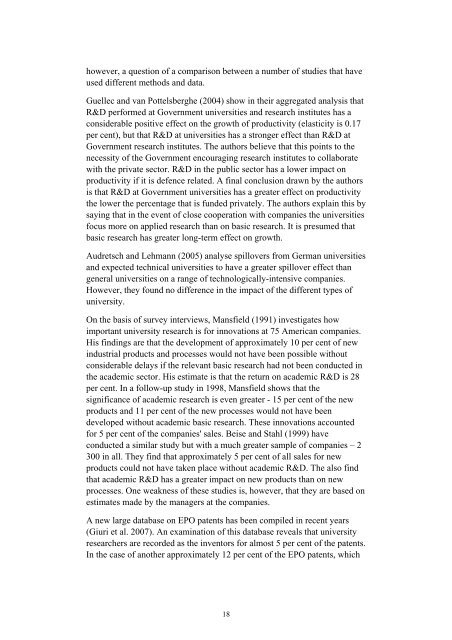Growth through Research and Development - what does ... - Vinnova
Growth through Research and Development - what does ... - Vinnova
Growth through Research and Development - what does ... - Vinnova
Create successful ePaper yourself
Turn your PDF publications into a flip-book with our unique Google optimized e-Paper software.
however, a question of a comparison between a number of studies that haveused different methods <strong>and</strong> data.Guellec <strong>and</strong> van Pottelsberghe (2004) show in their aggregated analysis thatR&D performed at Government universities <strong>and</strong> research institutes has aconsiderable positive effect on the growth of productivity (elasticity is 0.17per cent), but that R&D at universities has a stronger effect than R&D atGovernment research institutes. The authors believe that this points to thenecessity of the Government encouraging research institutes to collaboratewith the private sector. R&D in the public sector has a lower impact onproductivity if it is defence related. A final conclusion drawn by the authorsis that R&D at Government universities has a greater effect on productivitythe lower the percentage that is funded privately. The authors explain this bysaying that in the event of close cooperation with companies the universitiesfocus more on applied research than on basic research. It is presumed thatbasic research has greater long-term effect on growth.Audretsch <strong>and</strong> Lehmann (2005) analyse spillovers from German universities<strong>and</strong> expected technical universities to have a greater spillover effect thangeneral universities on a range of technologically-intensive companies.However, they found no difference in the impact of the different types ofuniversity.On the basis of survey interviews, Mansfield (1991) investigates howimportant university research is for innovations at 75 American companies.His findings are that the development of approximately 10 per cent of newindustrial products <strong>and</strong> processes would not have been possible withoutconsiderable delays if the relevant basic research had not been conducted inthe academic sector. His estimate is that the return on academic R&D is 28per cent. In a follow-up study in 1998, Mansfield shows that thesignificance of academic research is even greater - 15 per cent of the newproducts <strong>and</strong> 11 per cent of the new processes would not have beendeveloped without academic basic research. These innovations accountedfor 5 per cent of the companies' sales. Beise <strong>and</strong> Stahl (1999) haveconducted a similar study but with a much greater sample of companies – 2300 in all. They find that approximately 5 per cent of all sales for newproducts could not have taken place without academic R&D. The also findthat academic R&D has a greater impact on new products than on newprocesses. One weakness of these studies is, however, that they are based onestimates made by the managers at the companies.A new large database on EPO patents has been compiled in recent years(Giuri et al. 2007). An examination of this database reveals that universityresearchers are recorded as the inventors for almost 5 per cent of the patents.In the case of another approximately 12 per cent of the EPO patents, which18
















